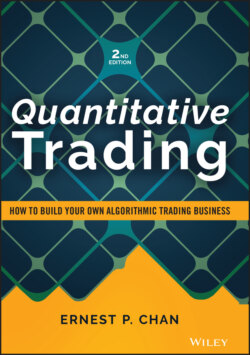Читать книгу Quantitative Trading - Ernest P. Chan - Страница 30
ARTIFICIAL INTELLIGENCE AND STOCK PICKING1
ОглавлениеThere was an article in the New York Times a short while ago about a new hedge fund launched by Mr. Ray Kurzweil, a pioneer in the field of artificial intelligence. (Thanks to my fellow blogger, Yaser Anwar, who pointed it out to me.) According to Kurzweil, the stock-picking decisions in this fund are supposed to be made by machines that “… can observe billions of market transactions to see patterns we could never see” (quoted in Duhigg, 2006).
While I am certainly a believer in algorithmic trading, it is a lot more difficult to successfully apply artificial intelligence to trading.
At the risk of oversimplification, we can characterize artificial intelligence (AI) as trying to fit past data points into a function with many, many parameters. This is the case for some of the favorite tools of AI: neural networks, decision trees, and genetic algorithms. With many parameters, we can for sure capture small patterns that no human can see. But do these patterns persist? Or are they random noises that will never replay again? Experts in AI assure us that they have many safeguards against fitting the function to transient noise. And indeed, such tools have been very effective in consumer marketing and credit card fraud detection. Apparently, the patterns of consumers and thefts are quite consistent over time, allowing such AI algorithms to work even with a large number of parameters. However, from my experience, these safeguards work far less well in financial markets prediction, and overfitting to the noise in historical data remains a rampant problem. As a matter of fact, I have built financial predictive models based on many of these AI algorithms in the past. Every time a carefully constructed model that seems to work marvels in backtest came up, they inevitably performed miserably going forward. The main reason for this seems to be that the amount of statistically independent financial data is far more limited compared to the billions of independent consumer and credit transactions available. (You may think that there is a lot of tick-by-tick financial data to mine, but such data is serially correlated and far from independent.)
This is not to say that no methods based on AI will work in prediction. The ones that work for me are usually characterized by these properties:
The targets are nonreflexive—targets that will not change their values in response to too many people successfully predicting them. If returns can be predicted, returns will change in response to the prediction. On the other hand, if weather can be predicted, weather will not change in response. Yet accurate weather prediction can benefit agricultural futures traders. Examples of financial targets that are nonreflexive include earnings surprises and nonfarm payroll surprises, both of which my research team has been successful in predicting (see predictnow.ai/blog/us-nonfarm-employment-prediction-using-riwi-corp-alternative-data/ for the latter).
The features (predictors) that are used as input for predictions are meaningful, numerous, and carefully scrubbed and engineered. For example many fundamental stock databases have embedded look-ahead bias because they report “restated” financials, not “point-in-time” financials. This look-ahead bias will make the backtest looks great, but will cause live trading performance to be much worse.
The prediction is applied to private instead of public targets. For example, instead of predicting the returns of SPY, AI should be used to predict whether your proprietary trading signals will be profitable. This way, you can avoid competing with many of the world's best financial machine learners in predicting the exact same target. This application of AI is called metalabeling. See how we applied metalabeling successfully at predictnow.ai/blog/what-is-the-probability-of-profit-of-your-next-trade-introducing-predictnow-ai/.
